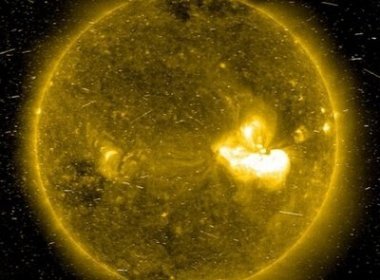WASHINGTON (AFP) – An unusual solar flare observed by a NASA space observatory on Tuesday could cause some disruptions to satellite communications and power on Earth over the next day or so, officials said.
The potent blast from the Sun unleashed a firestorm of radiation on a level not witnessed since 2006, and will likely lead to moderate geomagnetic storm activity by Wednesday, according to the National Weather Service.
"This one was rather dramatic," said Bill Murtagh, program coordinator at the NWS's Space Weather Prediction Center, describing the M-2 (medium-sized) solar flare that peaked at 1:41 am Eastern time in the United States, or 0541 GMT.

"We saw the initial flare occurring and it wasn't that big but then the eruption associated with it -- we got energy particle radiation flowing in and we got a big coronal mass injection," he said.
"You can see all the materials blasting up from the Sun so it is quite fantastic to look at."
NASA's solar dynamics observatory, which launched last year and provided the high-definition pictures and video of the event, described it as "visually spectacular," but noted that since the eruption was not pointed directly at Earth, the effects were expected to remain "fairly small."
"The large cloud of particles mushroomed up and fell back down looking as if it covered an area of almost half the solar surface," said a NASA statement.
Murtagh said space weather analysts were watching closely to see whether the event would cause any collision of magnetic fields between the Sun and Earth, some 93 million miles (150 million kilometers) apart.
"Part of our job here is to monitor and determine whether it is Earth-directed because essentially that material that is blasting out is gas with magnetic field combined," he told AFP.
"In a day or so from now we are expecting some of that material to impact us here on Earth and create a geomagnetic storm," he said.
"We don't expect it to be any kind of a real severe one but it could be kind of a moderate level storm."
The Space Weather Prediction Center said the event is "expected to cause G1 (minor) to G2 (moderate) levels of geomagnetic storm activity tomorrow, June 8, beginning around 1800 GMT."
Any geomagnetic storm activity will likely be over within 12-24 hours.
"The Solar Radiation Storm includes a significant contribution of high energy protons, the first such occurrence of an event of that type since December 2006," the NWS said.
As many as 12 satellites and spacecraft are monitoring the heliosphere, and one instrument in particular on board NASA's lunar reconnaissance orbiter is measuring radiation and its effects.
"Certainly over the (two-year) lifetime of the mission this is the most significant event," said Harlan Spence, principal investigator for the cosmic ray telescope for the effects of radiation, or CRaTER.
"This is really exciting because ironically when we were developing the mission initially we thought we would be launching closer to a solar maximum when these big solar particle events typically occur," Spence told AFP.
"Instead we launched into a historic solar minimum that took a long, long time to wake up," he said.
"This is interesting and significant because it shows the Sun is returning to its more typical active state."
The resulting geomagnetic storm could cause some disruption in power grids, satellites that operate global positioning systems and other devices, and may lead to some rerouting of flights over the polar regions, Murtagh said.
"Generally it is not going to cause any big problems, it will just have to be managed," he said.
"If you fly from the United States to Asia, flying over the North Pole, there are well over a dozen flights every day," he added.
"During these big radiation storms some of these airlines will reroute the flights away from the polar regions for safety reasons to make sure they can maintain communications.
"People operating satellites would keep an eye on this, too, because geomagnetic storming can interfere with satellites in various ways whether it is the satellite itself or the signal coming down from the receiver."
The aurora borealis (Northern Lights) and aurora australis (Southern Lights) will also likely be visible in the late hours of June 8 or 9, NASA said.
(한글요약)
태양 폭발, 통신설비 장애 예상
미국 국립항공우주국 (NASA)는 태양에서 비정상적인 활동이 지난 화요일에 관측되어, 조만간 지구 통신위성와 전력에 장애가 발생할 수 있다고 발표하였다.
이번에 태양에서 발생한 강력한 폭발은 화염폭풍을 촉발시켜 지난 2006년 이후로 최대치의 방사능이 측정되었다.
“처음에 화염이 관측되었을 때는 그렇게 규모가 크지는 않았다. 하지만 이를 따라 폭발이 발생했다. 에너지 입자 방사능이 발견되었고 대형 태양폭풍이 발생하였다,”고 한 NASA 관계자가 밝혔다.
NASA는 작년 태양활동관측위성(SDO)을 발사하여 이번 사건에 대한 고화질 사진 및 영상을 확보할 수 있었다. “시각적으로 화려한” 이번 사건은 그러나 지구를 직접적으로 향해 발생한 것은 아니기 때문에 미치는 영향은 미미할 것이라는 관측이다.
연구진들은 “내일 혹은 곧 이번 폭발로 발생한 물질이 지구에 영향을 미쳐 지자기(地磁氣) 폭풍이 발생할 수도 있다”고 언론을 통해 밝혔다. 하지만 발생하더라도 그 규모는 크지 않을 전망이고, 12-24 시간 이내에 끝날 것으로 전망하고 있다.
지자기 폭풍이 발생할 경우 지구의 파워 그리드, GPS 위성, 그리고 양극 지역을 경유하는 비행기 항로 등에 영향을 줄 것으로 예상된다.
“인공 위성을 조종하는 사람들은 이번 사건에 주목을 해야 한다. 지자기 폭풍은 다양한 방식으로 인공위성 기기 자체, 혹은 통신 신호 등에 영향을 미칠 수 있기 때문이다”라고 연구진들은 덧붙였다.











![[Today’s K-pop] BTS pop-up event to come to Seoul](http://res.heraldm.com/phpwas/restmb_idxmake.php?idx=644&simg=/content/image/2024/04/17/20240417050734_0.jpg&u=)




![[KH Explains] Hyundai's full hybrid edge to pay off amid slow transition to pure EVs](http://res.heraldm.com/phpwas/restmb_idxmake.php?idx=652&simg=/content/image/2024/04/18/20240418050645_0.jpg&u=20240418181020)

![[Today’s K-pop] Zico drops snippet of collaboration with Jennie](http://res.heraldm.com/phpwas/restmb_idxmake.php?idx=642&simg=/content/image/2024/04/18/20240418050702_0.jpg&u=)